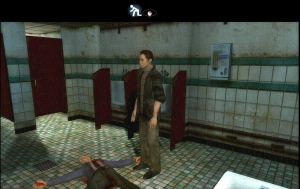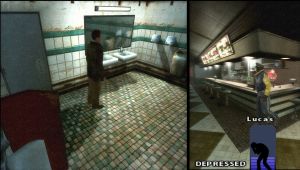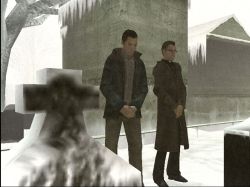Indigo Weekend
January 23, 2006 - Games - Reviews
This Saturday, Linda was away for a girls' weekend, and I finally got around to installing Indigo Prophecy. I played through the entire game. I'm not sure that I've ever done that before, but the game was just so engaging and addictive that I played through in about 3-4 sittings between Saturday afternoon and Sunday morning.
 The first thing I noticed during the tutorial was the camera control scheme. It was set up differently than other games I've played, and I liked it a lot. Hold the left mouse button and move the mouse to pan the camera around your character. Hold the right button and move the mouse to pivot the camera away from your character. Hold the center mouse button and move the mouse for first person "free look". Very nice. In situations where you're not allowed to pivot the camera, you right click to toggle between 2-4 fixed view angles. The controls took a bit of getting used to, but once you get used to them, they work well.
The first thing I noticed during the tutorial was the camera control scheme. It was set up differently than other games I've played, and I liked it a lot. Hold the left mouse button and move the mouse to pan the camera around your character. Hold the right button and move the mouse to pivot the camera away from your character. Hold the center mouse button and move the mouse for first person "free look". Very nice. In situations where you're not allowed to pivot the camera, you right click to toggle between 2-4 fixed view angles. The controls took a bit of getting used to, but once you get used to them, they work well.
The other thing I noticed immediately and loved is that you can pause the game at any time, even during cutscenes. This is huge for me, as I often have to get up to thwart the cat after it jumps on the counter, or to answer the phone. Small feature, but it was very welcome.
Indigo Prophecy is essentially a murder mystery, but it differs from other games in that you go back and forth between playing the detectives and the murderer, who is questioning whether or not he actually comitted the murder. The game features a number of action sequences, in which you must either perform specific mouse gestures, tap the left-right arrows quickly, or tap arrow keys in a very DDR-like manner. I set the difficulty to "normal", but in retrospect I could have handled "hard" without much problem - the action sequences were easier than I'd anticipated. There are also a large number of minigames within Indigo Prophecy - everything from target practice at the shooting range to playing with a yoyo to dodging oncoming traffic. But the real lure of the game wasn't its challenge. The only time I actually died while playing is when I mixed alcohol and aspirin. The real lure was the innovative gameplay and the wonderful storyline.
 Another thing about the game I thought was great is that if a puzzle proves too difficult, you can skip it. Often, when I'm playing adventure games, I'll hit a puzzle that I just can't figure out, and the only way to get past it is to look for the solution online. I hate doing that. I got stuck twice in Indigo Prophecy: once with a puzzle and once with an action sequence. I couldn't locate the old chinese man's book for him, and the game let me leave without locating that clue. Otherwise, I'd still be stuck on it. Also, I couldn't figure out how to properly perform the mouse gesture to give a child CPR. Even after I beat the game, I went back and couldn't do it. So as crappy as it sounds, the game allowed me to walk away and let the child die. But boy, that did a number on my character's mental state.
Another thing about the game I thought was great is that if a puzzle proves too difficult, you can skip it. Often, when I'm playing adventure games, I'll hit a puzzle that I just can't figure out, and the only way to get past it is to look for the solution online. I hate doing that. I got stuck twice in Indigo Prophecy: once with a puzzle and once with an action sequence. I couldn't locate the old chinese man's book for him, and the game let me leave without locating that clue. Otherwise, I'd still be stuck on it. Also, I couldn't figure out how to properly perform the mouse gesture to give a child CPR. Even after I beat the game, I went back and couldn't do it. So as crappy as it sounds, the game allowed me to walk away and let the child die. But boy, that did a number on my character's mental state.
 That's another really interesting facet of the game - your character's mental state will go up and down dependant on certain actions you take. The lower it gets, the more anxious and depressed you become. If you get too depressed, you break down and lose the game. Little actions like having a drink of coffee or playing some music on the guitar relax you and improve your mental state, whereas looking at a picture of an ex-girlfriend or hearing about the murder on the radio stress you out and decrease your mental state. It's a really cool gameplay twist.
That's another really interesting facet of the game - your character's mental state will go up and down dependant on certain actions you take. The lower it gets, the more anxious and depressed you become. If you get too depressed, you break down and lose the game. Little actions like having a drink of coffee or playing some music on the guitar relax you and improve your mental state, whereas looking at a picture of an ex-girlfriend or hearing about the murder on the radio stress you out and decrease your mental state. It's a really cool gameplay twist.
One of my only gripes with the game is that it takes place in Manhattan, and everyone has huge apartments with tons of open unused space. Apparently, the game's art designers have never been to The City. The game also has a few fairly graphic scenes, where you see a woman in a thong or catch a glimpse of panties, but from what I hear it's nothing compared to the European version of the game, Fahrenheit, which has hot coffee-like sequences.
So this game's a keeper. I'm going to try to get Linda to play it, since she enjoyed Syberia so much.